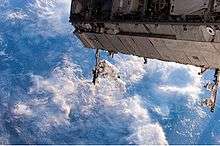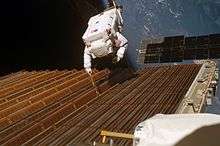Robert Curbeam
| Robert L. Curbeam, Jr. | |
|---|---|
 | |
| NASA Astronaut | |
| Nationality | American |
| Status | Retired |
| Born |
Robert Lee Curbeam, Jr. March 5, 1962 Baltimore, Maryland, U.S. |
Other occupation | Naval flight officer, test pilot, engineer |
|
USNA, B.S. 1984 NPS, M.S. 1990, M.S. 1991 | |
| Rank | Captain, USN |
Time in space | 37d 14h 33m 23s |
| Selection | 1994 NASA Group 15 |
Total EVAs | 7 |
Total EVA time | 45 hours, 34 minutes |
| Missions | STS-85, STS-98, STS-116 |
Mission insignia |
|
Robert Lee Curbeam, Jr. (born March 5, 1962) is a former NASA astronaut and captain in the United States Navy.[1]
Curbeam graduated from Woodlawn High School, Baltimore County, Maryland in 1980. He earned a Bachelor of Science degree in Aerospace Engineering from the United States Naval Academy in 1984, a Master of Science degree in Aeronautical Engineering from the Naval Postgraduate School in 1990, and a master's degree in Astronautical Engineering from the Naval Postgraduate School in 1991.
He is a member of the U.S. Naval Academy Alumni Association and the Association of Old Crows.
Curbeam was named Fighter Wing One Radar Intercept Officer of the Year in 1989 and received the U.S. Naval Test Pilot School Best Developmental Thesis (DT-II) Award.
He currently holds the record for the most spacewalks during a single spaceflight. During the STS-116 mission, Curbeam completed four spacewalks.[1]
Naval career
Upon graduation from the U.S. Naval Academy, Curbeam commenced Naval Flight Officer training in 1984. In 1986 he reported to Fighter Squadron 11 (VF-11) and made overseas deployments to the Mediterranean and Caribbean Seas, and the Arctic and Indian Oceans on board the aircraft carrier USS Forrestal. During his tour in VF-11, he also attended the Navy Fighter Weapons School (TOPGUN).
Upon graduation of United States Naval Test Pilot School in December 1991, he reported to the Strike Aircraft Test Directorate, where he was the project officer for the F-14A/B Air-to-Ground Weapons Separation Program. In August 1994, he returned to the U.S. Naval Academy as an instructor in the Weapons and Systems Engineering Department.
NASA career
Selected by NASA in December 1994, Curbeam reported to the Johnson Space Center in March 1995. After completing a year of training and evaluation, he was assigned to the Computer Support Branch in the Astronaut Office. He is a veteran of three space flights: STS-85 in 1997, STS-98 in 2001, STS-116 in 2006, and has logged over 901 hours in space, including over 45 hours during three spacewalks.[1]
Between the first two flights, Curbeam served as a spacecraft communicator (CAPCOM) responsible for relaying all voice communication between Mission Control and crews aboard the Space Shuttle and International Space Station. After his second flight, he also served as the CAPCOM Branch Chief. During the spring of 2002, he served as Deputy Associate Administrator for Safety and Mission Assurance, at NASA Headquarters, Washington, D.C.
Spaceflight experience

STS-85 (August 7–19, 1997) was a 12-day mission during which the crew deployed and retrieved the CRISTA-SPAS payload, operated the Japanese Manipulator Flight Demonstration (MFD) robotic arm, studied changes in the Earth's atmosphere and tested technology destined for use on the future International Space Station. The mission was accomplished in 189 Earth orbits, traveling 4.7 million miles in 284 hours and 27 minutes.[1]
STS-98 (February 7–20, 2001) continued the task of building and enhancing the International Space Station by delivering the U.S. laboratory module Destiny. The Shuttle spent seven days docked to the station while Destiny was attached. In helping to complete its assembly Curbeam logged over 19 EVA hours in 3 space walks. The crew also relocated a docking port, and delivered supplies and equipment to the resident Expedition 1 crew. Mission duration was 12 days, 21 hours, 20 minutes.[1]

STS-116 (December 9–22, 2006), launched December 9, 2006 at 8:47 p.m. EST, was a mission to the International Space Station. The mission involved the installation of a new truss segment, and the rewiring of the station's electrical system. They also returned ISS Flight Engineer Thomas Reiter to Earth after six months in space. Astronaut Sunita Williams remained on board the space station. During the mission astronaut Curbeam was the EVA crewmember for the record-breaking four spacewalks, three of which were conducted along with astronaut Christer Fuglesang (Sweden), and one along with astronaut Sunita Williams. Along with rewiring the station's electrical system, Curbeam and Fuglesang aided in the retraction of a sticking solar array on December 18, 2006. In performing this unexpected fourth EVA to aid in the retraction of the array, Curbeam became the first person to perform four spacewalks on a single mission.[1]
After NASA
On December 7, 2007, NASA announced that Curbeam had chosen to leave NASA after 13 years, to pursue a job in the private sector.[2] He presently works for Raytheon as Vice President of Mission Assurance in Massachusetts.
Having played lacrosse as a student athlete at the Naval Academy, Curbeam went on to become an assistant coach for the boys lacrosse team at Clear Lake High School in Houston, Texas. In 2011, Curbeam led Clear Lake to the semifinal match of the Texas High School Lacrosse League South District Championship game. Clear Lake ended the match with a loss to the then number 1 ranked lacrosse team in Texas, Hillcrest High School.[3]
See also
References
- 1 2 3 4 5 6 NASA (2007). "Robert L. Curbeam, Jr., (Captain, USN)". National Aeronautics and Space Administration. Retrieved December 7, 2007.
- ↑ NASA (2007). "Veteran Astronaut and Spacewalker Robert Curbeam Leaves NASA". NASA. Retrieved December 7, 2007.
- ↑ http://www.yourhoustonnews.com/bay_area/sports/south-district-lacrosse-champ-clear-lake-boys-fall-in-close/article_c22c46a6-14ab-5585-96ef-86c9f177bf0e.html